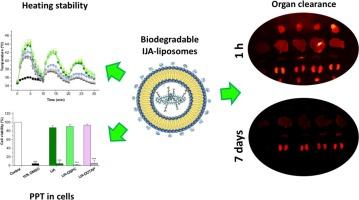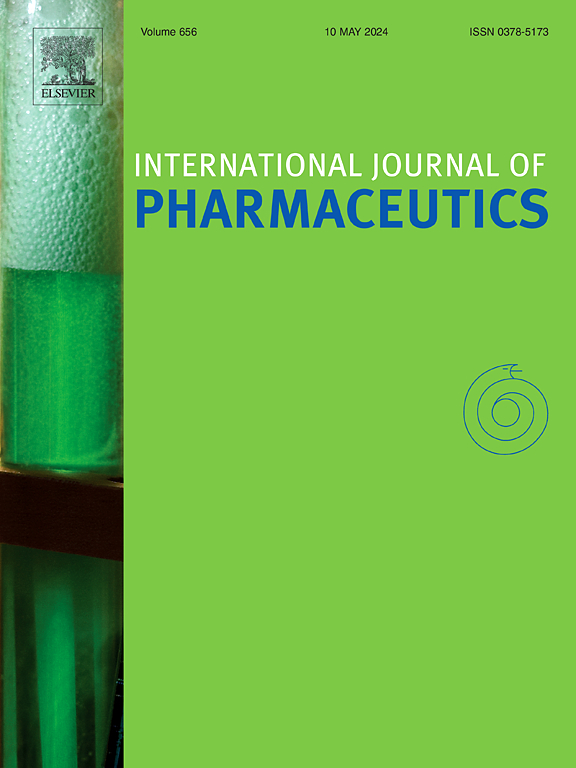Biodegradable lipid bilayer-assisted indocyanine green J- aggregates for photothermal therapy: Formulation, in vitro toxicity and in vivo clearance
IF 5.2
2区 医学
Q1 PHARMACOLOGY & PHARMACY
引用次数: 0
Abstract
Indocyanine green (ICG) J-aggregates (IJA) are a unique form of aggregation that exhibits superior properties to monomeric ICG. Despite their higher photoacoustic (PA) signals for imaging and heating stability during photothermal therapy (PTT), they exhibit low stability under a biological milieu. Our group previously proposed a simple procedure for in-situ preparation of IJA into liposomes, accelerating their formation and optical properties. To comprehend their potential applications, we systematically investigated the effect of the lipid bilayer composition on ICG J-aggregation and stability. Moreover, their in vitro compatibility and photothermal toxicity in monolayers and cancer spheroids, besides their in vivo biodistribution and clearance were evaluated. Our findings revealed the importance of high cholesterol and PEG-lipid content and low charged lipids (∼ 5 mol %) in liposomes to promote a high IJA/ICG ratio and, thus, high heating stability. More importantly, IJA-liposomes revealed high biocompatibility in monolayer and cancer spheroids with efficient photothermal toxicity. Finally, IJA-liposomes were cleared from the body without toxicity. Interestingly, IJA-liposomes mainly showed lower affinity to the liver than monomeric ICG, resulting in higher renal clearance. Overall, our biodegradable IJA-liposomes could be an excellent alternative to gold-based agents suitable for PA imaging and cancer PTT.

用于光热疗法的可生物降解脂质双分子层辅助吲哚菁绿 J-聚集体:配方、体外毒性和体内清除。
吲哚菁绿(ICG)J-聚集体(IJA)是一种独特的聚集形式,与单体 ICG 相比具有更优越的特性。尽管它们具有更高的光声(PA)成像信号和光热疗法(PTT)期间的加热稳定性,但在生物环境中却表现出较低的稳定性。我们的研究小组之前提出了一种将 IJA 原位制备到脂质体中的简单程序,从而加速了它们的形成并提高了它们的光学特性。为了理解它们的潜在应用,我们系统地研究了脂质双分子层组成对 ICG J 聚集和稳定性的影响。此外,我们还评估了它们在单层和癌症球体内的体外相容性和光热毒性,以及它们在体内的生物分布和清除率。我们的研究结果表明,脂质体中胆固醇和 PEG 脂质含量高、带电脂质含量低(∼ 5 mol %)对提高 IJA/ICG 比率,从而提高加热稳定性非常重要。更重要的是,IJA 脂质体在单层和癌症球体内显示出很高的生物相容性,具有高效的光热毒性。最后,IJA 脂质体可从体内清除,无毒性。有趣的是,与单体 ICG 相比,IJA 脂质体对肝脏的亲和力较低,因此肾脏清除率较高。总之,我们的生物可降解 IJA 脂质体可以很好地替代金基制剂,适用于 PA 成像和癌症 PTT。
本文章由计算机程序翻译,如有差异,请以英文原文为准。
求助全文
约1分钟内获得全文
求助全文
来源期刊
CiteScore
10.70
自引率
8.60%
发文量
951
审稿时长
72 days
期刊介绍:
The International Journal of Pharmaceutics is the third most cited journal in the "Pharmacy & Pharmacology" category out of 366 journals, being the true home for pharmaceutical scientists concerned with the physical, chemical and biological properties of devices and delivery systems for drugs, vaccines and biologicals, including their design, manufacture and evaluation. This includes evaluation of the properties of drugs, excipients such as surfactants and polymers and novel materials. The journal has special sections on pharmaceutical nanotechnology and personalized medicines, and publishes research papers, reviews, commentaries and letters to the editor as well as special issues.

 求助内容:
求助内容: 应助结果提醒方式:
应助结果提醒方式:


